闽教版小学英语第七册教案
- 格式:doc
- 大小:104.51 KB
- 文档页数:13
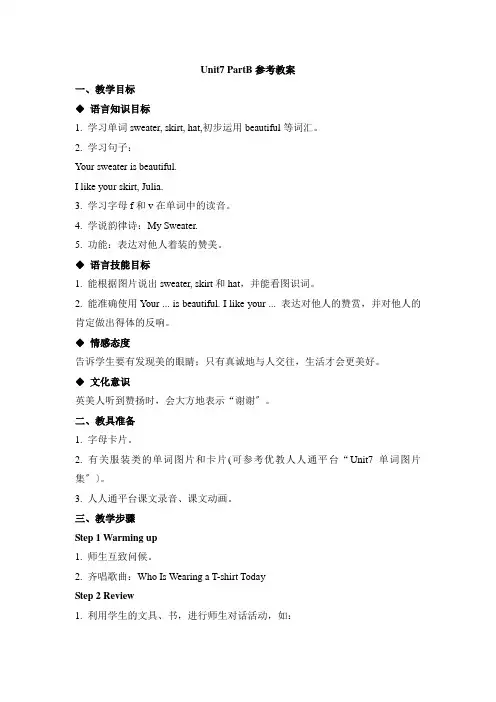
Unit7 PartB参考教案一、教学目标◆语言知识目标1. 学习单词sweater, skirt, hat,初步运用beautiful等词汇。
2. 学习句子:Your sweater is beautiful.I like your skirt, Julia.3. 学习字母f和v在单词中的读音。
4. 学说韵律诗:My Sweater.5. 功能:表达对他人着装的赞美。
◆语言技能目标1. 能根据图片说出sweater, skirt和hat,并能看图识词。
2. 能准确使用Your ... is beautiful. I like your ... 表达对他人的赞赏,并对他人的肯定做出得体的反响。
◆情感态度告诉学生要有发现美的眼睛;只有真诚地与人交往,生活才会更美好。
◆文化意识英美人听到赞扬时,会大方地表示“谢谢〞。
二、教具准备1. 字母卡片。
2. 有关服装类的单词图片和卡片(可参考优教人人通平台“Unit7 单词图片集〞〕。
3. 人人通平台课文录音、课文动画。
三、教学步骤Step 1 Warming up1. 师生互致问候。
2. 齐唱歌曲:Who Is Wearing a T-shirt TodayStep 2 Review1. 利用学生的文具、书,进行师生对话活动,如:教师:Hello! Whose pencil-box is this学生:It’s ×××’s.教师:(找到物品主人后〕Your pencil-box is beautiful. I like it. Here you are.学生:Thank you.先师生示范,然后请学生自由对话。
2. 复习有关服装类的单词和句子。
(1) 出示单词卡片jacket, shirt和T-shirt,让学生认读。
(2) 游戏——转转乐。
游戏规那么:全班一起唱歌曲:Who Is Wearing a T-shirt Today?教师将三张单词卡片分别从不同组的第一位学生开始传,歌曲停止时,拿到卡片的学生起立,由他/她同桌的同学提问:“Whose ... is this〞全班学生答复:“It’s ×××’s.〞同桌同学再问:“What size do you wear〞拿到卡片的学生答复:“Size ...〞3. 揭示并板书课题:Unit 7 Clothes(2〕Part BStep 3 Presentation(一) 学习单词sweater, skirt和hat1. 学习单词sweater。
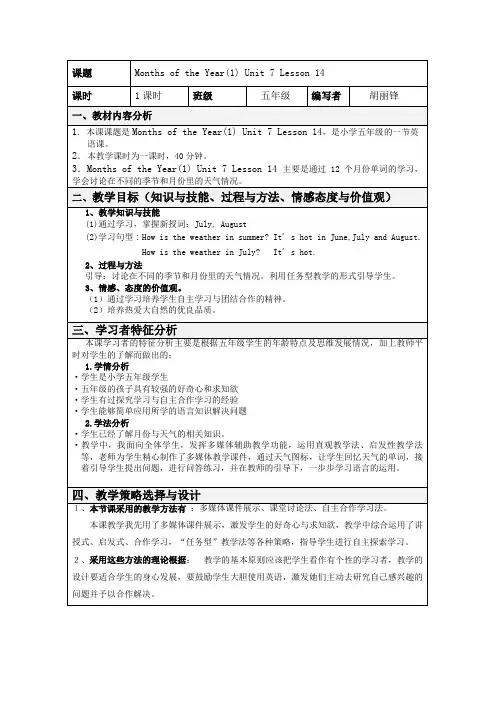
Unit 7 Months of the Year(1) Lesson 14教学反思一、本节课的优点在小学英语教学中注重创设情景,因为情景既可以满足小学生的心理需要,引起他们的有意注意,还可以让他们从小就明白学习英语是为交际服务的;而且学生在有情景的活动中学习英语,有身临其境的感觉,能加深他们所学英语知识的印象。
本单元中“天气”是与实际生活紧密联系的,也是学生所熟悉的。
在设计过程中,我首先问孩子们“How is the weather?”,联系实际,并用动作来引导学生进行回答“It’s warm.”或“It’s hot.”关于课件,首先通过一首有关天气的歌曲吸引学生的注意力,渲染课堂气氛,让学生感受所要学习的内容是有关天气的,为下面的教学作铺垫。
其次,在教学完四季及四季的天气后,我通过询问学生“Which seasons are in spring?”来引入季节“July”和“August”,中间穿插chant:spring,spring,spring is warm. Summer,summer,summer is hot.来帮助孩子们记忆天气。
此过程中不断呈现句型”How is the weather?”做到词不离句,句不离词,贴近学生的生活实际。
《英语课程标准》提倡任务型教学。
任务型教学以任务为目标,要求学生在完成任务也就是学习过程中去建构知识,提高语言运用能力。
在新授完句型和天气时,我让孩子们听录音尝试回答问题“How is the weather in April? How is the weather in August? What do they often do in summer?”来驱动学生听音理解。
一方面对本课所学的主要单词和句型进行巩固,另一方面帮助学生尝试完成一个任务。
但是,整堂课对于“任务型”教学还有所欠缺,应加强理论学习和实际锻炼。
二、本节课的不足1.没有处理好整节课的时间,时间的掌控上稍微不足,在最后的图片呈现中略快,可是适当拓展,让孩子们说完整句“It’s in …”3.板书有些凌乱,如可以季节的用同一种颜色,月份用同一种颜色,天气用同一种颜色。
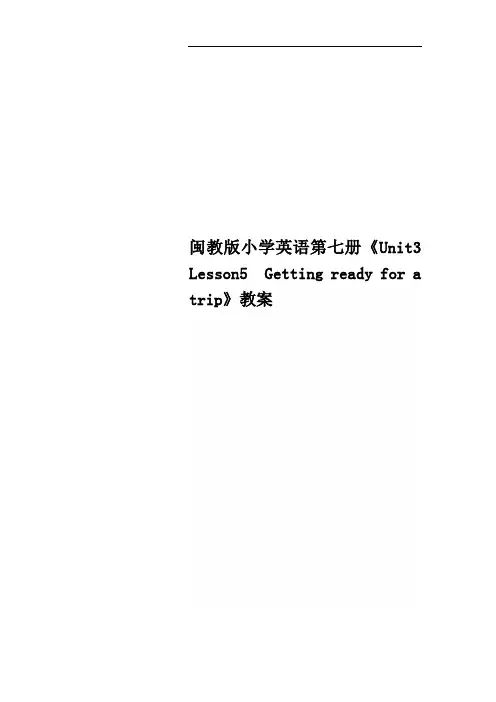
闽教版小学英语第七册《Unit3 Lesson5 Getting ready for a trip》教案小学英语教案学科:小学英语课例名称:闽教版英语第七册《Unit3 Lesson5 Getting ready for a trip》课型:巩固课年级:六年级教材版本:闽教版英语第七册教学设计:一、学生分析六年级孩子已能听、说、读、写一些英语单词和句子;能听懂一些英语对话,并作回答;能根据一定的情景组织简单的对话并进行表演;能够提一些简单的问题并回答。
他们已具备一定的英语知识、技能和语言的综合运用能力;他们的自主学习能力有所提高,思维不像三、四年级时停留在表象;他们的心理已产生微妙的变化,由活泼好动过渡为文静,不太喜欢表现自我;他们学习的欲望不停留于几个活动和游戏,他们还没有形成科学的英语学习方法并用英语进行思维的习惯。
但他们大都有与他人合作,交流学习的意愿,能在学习中体验到学习的成就和快乐。
二、教材分析本课为闽教版第七册Unit3第一课时的教学。
以trip为话题,内容贴近学生生活实际,语言材料真实。
本课的学习是学生在学习过第四册、第五册的一般将来时态后,进一步复习、巩固和延伸、拓展,并为这一单元的下几课时的学习作好铺垫。
在第四、第五册中,学生已学过的句型有:What will you do in summer?I will---. Where did you go in the summer vacation? How did you go there? What did you do there?而本课的主要语言结构为:Where will you go for the holidays? What will you do there? How will you go there? When will you go---? 等一般将来时的疑问句式及其回答。
本课时的学习符合学生的心理特点和认知规律。
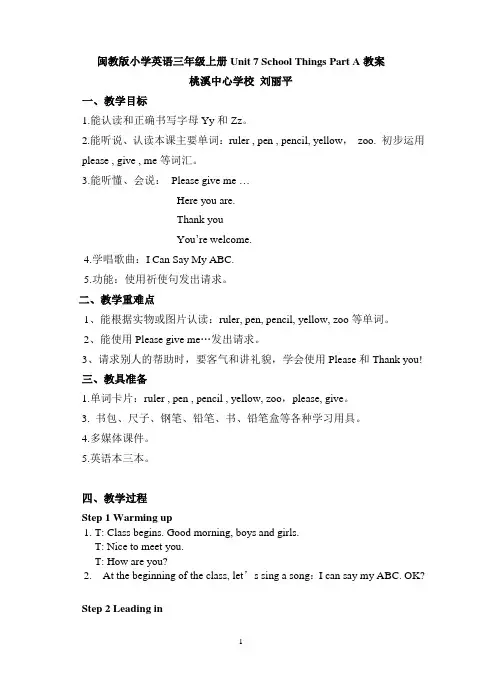
闽教版小学英语三年级上册Unit 7 School Things Part A教案桃溪中心学校刘丽平一、教学目标1.能认读和正确书写字母Yy和Zz。
2.能听说、认读本课主要单词:ruler , pen , pencil, yellow,zoo. 初步运用please , give , me等词汇。
3.能听懂、会说:Please give me …Here you are.Thank youYou’re welcome.4.学唱歌曲:I Can Say My ABC.5.功能:使用祈使句发出请求。
二、教学重难点1、能根据实物或图片认读:ruler, pen, pencil, yellow, zoo等单词。
2、能使用Please give me…发出请求。
3、请求别人的帮助时,要客气和讲礼貌,学会使用Please和Thank you!三、教具准备1.单词卡片:ruler , pen , pencil , yellow, zoo,please, give。
3. 书包、尺子、钢笔、铅笔、书、铅笔盒等各种学习用具。
4.多媒体课件。
5.英语本三本。
四、教学过程Step 1 Warming up1. T: Class begins. Good morning, boys and girls.T: Nice to meet you.T: How are you?2.At the beginning of the class, let’s sing a song:I can say my ABC. OK? Step 2 Leading in1. Wow, a nice song. Right? Look! What’s this? It’s a bag. Can you guess what’s in the bag? Hands up, please. (指名答)2. They are both…? 他们都是跟学习有关的什么?(将所有的文具出示)Yes! They are school things. (板书课题:Unit 7 School Things Part A)Read after me: school things, school things.3.So many school things! Today, let’s learn how to say them inEnglish ,OK?4.First: we’ll score on the blackboard and see which group wins.(板书:G1,G2,G3,G4)Step 3 Presentation1. 教学单词ruler, pen, pencil.(1)(出示图片)Boys and girls, look here. What’s this?Yes! It’s a ruler . Read after me: ruler. (领读数遍后,升升降调读)ruler, ruler, ruler.(领读数遍后,指名读,竖小排开火车读,贴图,板书a ruler)。
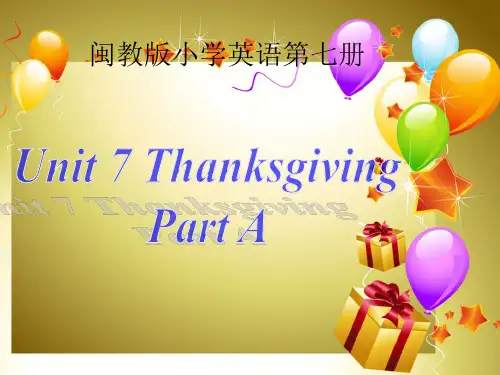
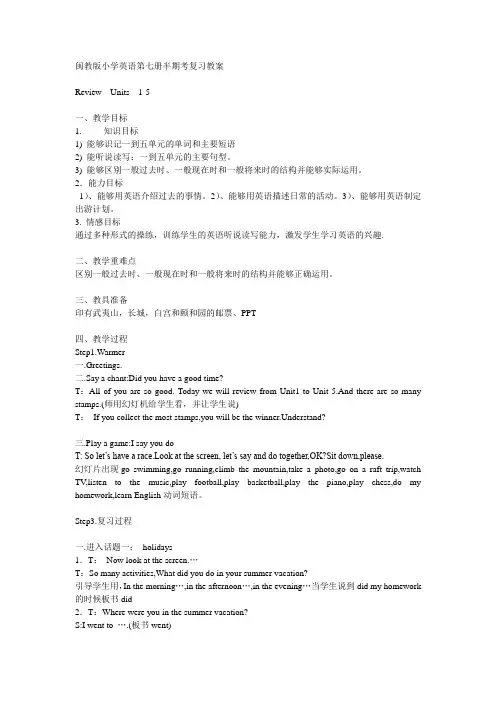
闽教版小学英语第七册半期考复习教案Review Units 1-5一、教学目标1. 知识目标1) 能够识记一到五单元的单词和主要短语2) 能听说读写:一到五单元的主要句型。
3) 能够区别一般过去时、一般现在时和一般将来时的结构并能够实际运用。
2.能力目标1)、能够用英语介绍过去的事情。
2)、能够用英语描述日常的活动。
3)、能够用英语制定出游计划。
3. 情感目标通过多种形式的操练,训练学生的英语听说读写能力,激发学生学习英语的兴趣.二、教学重难点区别一般过去时、一般现在时和一般将来时的结构并能够正确运用。
三、教具准备印有武夷山,长城,白宫和颐和园的邮票、PPT四、教学过程Step1.Warmer一.Greetings.二.Say a chant:Did you have a good time?T:All of you are so good. Today we will review from Unit1 to Unit 5.And there are so many stamps.(师用幻灯机给学生看,并让学生说)T:If you collect the most stamps,you will be the winner.Understand?三.Play a game:I say you doT: So let’s have a race.Look at the screen, let’s say and do together,OK?Sit down,please.幻灯片出现go swimming,go running,climb the mountain,take a photo,go on a raft trip,watch TV,listen to the music,play football,play basketball,play the piano,play chess,do my homework,learn English动词短语。
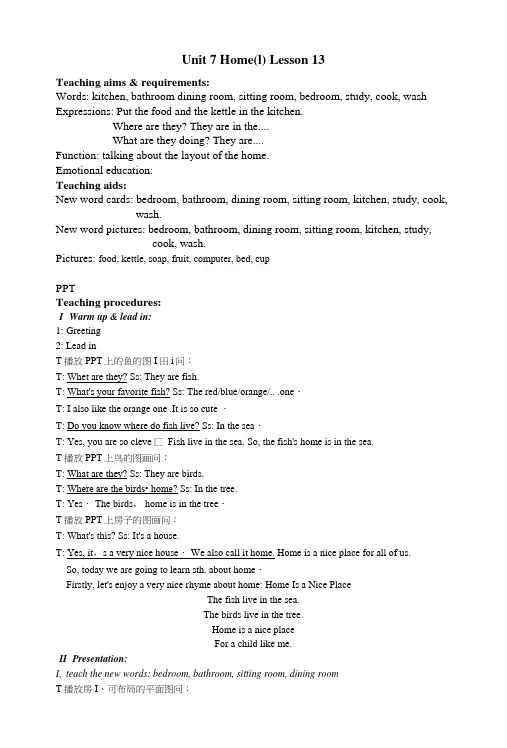
Unit 7 Home(l) Lesson 13Teaching aims & requirements:Words: kitchen, bathroom dining room, sitting room, bedroom, study, cook, wash Expressions: Put the food and the kettle in the kitchen.Where are they? They are in the....What are they doing? They are....Function: talking about the layout of the home.Emotional education:Teaching aids:New word cards: bedroom, bathroom, dining room, sitting room, kitchen, study, cook, wash.New word pictures: bedroom, bathroom, dining room, sitting room, kitchen, study,cook, wash.Pictures: food, kettle, soap, fruit, computer, bed, cupPPTTeaching procedures:I Warm up & lead in:1: Greeting2: Lead inT播放PPT上的鱼的图I田i问:T: Whet are they? Ss: They are fish.T: What's your favorite fish? Ss: The red/blue/orange/.. .one・T: I also like the orange one .It is so cute ・T: Do you know where do fish live? Ss: In the sea・T: Yes, you are so cleve匚Fish live in the sea. So, the fish's home is in the sea.T播放PPT上鸟的图画问:T: What are they? Ss: They are birds.T: Where are the birds• home? Ss: In the tree.T: Yes・ The birds, home is in the tree・T播放PPT上房子的图画问:T: What's this? Ss: It's a house.T: Yes, it,s a very nice house・ We also call it home. Home is a nice place for all of us.So, today we are going to learn sth. about home・Firstly, let's enjoy a very nice rhyme about home: Home Is a Nice PlaceThe fish live in the sea.The birds live in the tree.Home is a nice placeFor a child like me.II Presentation:I,teach the new words: bedroom, bathroom, sitting room, dining roomT播放房I、可布局的平面图问:T: What's this? This is the layout of a house. There are many rooms in this house・ Now let^s go to have a look one by one・T播放床铺的图片:T: Whafs this?Ss: It's a bed.T: Yes, it is a bed. Where should we put the bed?Ss: In the bedroom.T: Yes, we should put the bed in the bedroom.升降调+chant练习(T手拿bedroom的词卡)T: bedroom, bedroom、put the bed in (he bedroom.SI, please chant after me. (T 将bedroom 写在黑板上)Gl, chant after me. (T 将bedroom 词卡贴在黑板上)The whole class chant after me.T播放肥皂的图片:T: Whafs this?Ss: IFs soup・(T 要预防有些学生说成:It is a soap.要纠正:It is soup./ It is a bar of soap.)T: Yes, it is a bar of soap・ Where should we put the soap?Ss: In the bathroom.T: Yes, we should put the soap in the bathroom.升降调+chant练习(T手拿bathroom的词卡)T: bathroom, bathroom, put the bed in the bathroom.All the boys, please chant after me. (T 将bathroom 写在黑板上)All the girls chant after me. (T 将bathroom 词卡贴在黑板上)The whole class chant after me.T播放TV & tea的图片:T: Whafs this?Ss: It's a TV. It's tea.T: Where should we put the TV & tea?Ss: In the sitting room.T: Yes, we should put the TV & lea in the sitting room.升降调+chant练习(T手拿sitting room的词卡)Any volunteer who chant it correctly will win one star for his or her group・Any volunteer want to have a try?(对表现好的学生给予肯定:Good job./ Great.AVell done…对表现不够理想的学生:It doesn't matter. Anyway, good try.并给表现好的学生所在的组加上星星。
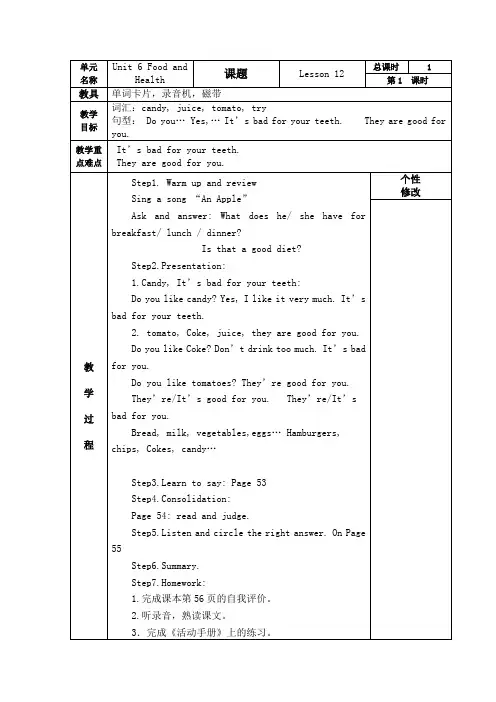
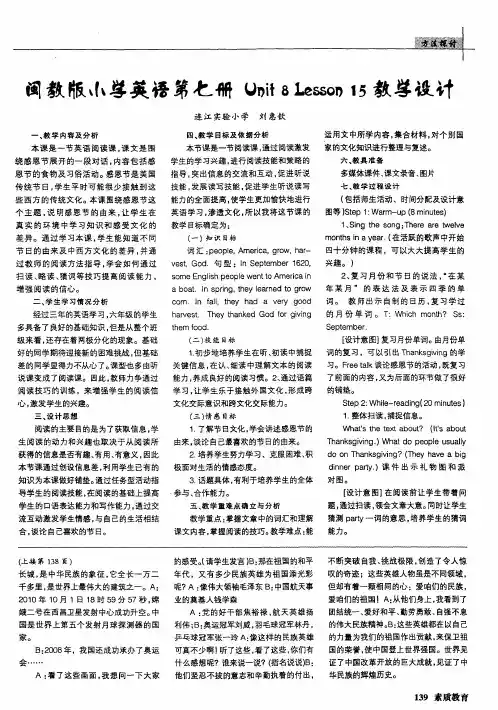

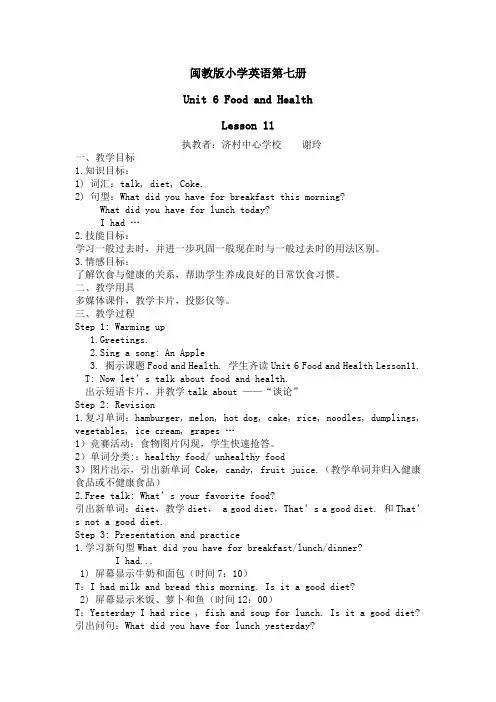
闽教版小学英语第七册Unit 6 Food and HealthLesson 11执教者:济村中心学校谢玲一、教学目标1.知识目标:1) 词汇:talk, diet, Coke.2) 句型:What did you have for breakfast this morning?What did you have for lunch today?I had …2.技能目标:学习一般过去时,并进一步巩固一般现在时与一般过去时的用法区别。
3.情感目标:了解饮食与健康的关系,帮助学生养成良好的日常饮食习惯。
二、教学用具多媒体课件,教学卡片,投影仪等。
三、教学过程Step 1: Warming up1.Greetings.2.Sing a song: An Apple3. 揭示课题Food and Health. 学生齐读Unit 6 Food and Health Lesson11. T: Now let’s talk about food and health.出示短语卡片,并教学talk about ——“谈论”Step 2: Revision1.复习单词:hamburger, melon, hot dog, cake, rice, noodles, dumplings, vegetables, ice cream, grapes …1)竞赛活动:食物图片闪现,学生快速抢答。
2)单词分类::healthy food/ unhealthy food3)图片出示,引出新单词Coke, candy, fruit juice.(教学单词并归入健康食品或不健康食品)2.Free talk: What’s your favorite food?引出新单词:diet,教学diet, a good diet,That’s a good diet. 和That’s not a good diet.Step 3: Presentation and practice1.学习新句型What did you have for breakfast/lunch/dinner?I had...1) 屏幕显示牛奶和面包(时间7:10)T:I had milk and bread this morning. Is it a good diet?2) 屏幕显示米饭、萝卜和鱼(时间12:00)T:Yesterday I had rice , fish and soup for lunch. Is it a good diet? 引出问句:What did you have for lunch yesterday?I had …3) 屏幕显示汉堡、可乐和薯条(时间17:30)T:Yesterday I had a hamburger, Coke and chips for dinner. Is it a good diet?4) 限时比赛:30秒钟,两两问答,完成人数多的小组获胜。
Unit7 Part B教学设计教学目标◆语言知识目标1.学习词汇:help yourselves,corn,soup,salad,better,luck等。
2.学习句型:Pass me the…,please.Here you are.Would you like some…?Yes,please.3.功能:谈论节日。
◆语言技能目标1.能使用句型Would you like…?询问他人是否想要某种食物。
2.能就所学知识进行简短的对话。
3.能用所学的单词表达不同节日中的不同食物。
◆情感态度培养热情好客的良好品质。
◆文化意识1.通过感恩节,了解西方国家的饮食文化。
2.知道中西方不同的就餐习惯和就餐礼仪。
教具准备1.单词卡片:help yourselves,corn,soup,salad,better,luck等。
2.一个小篮子。
3.教材配套的音频和动画素材。
教学过程Step 1Warming up1.师生互致问候。
2.学唱歌曲:Happy Thanksgiving to You。
3.通过歌曲,揭示并板书课题:Unit 7 ThanksgivingPart B。
Step 2Review1.师生自由对话,复习上节课的内容。
When is Thanksgiving?How do American people spend Thanksgiving?Can Sally invite her friends to the dinner?…2.通过上节课的课后作业,引出有关食物的复习。
(1)教师说:“Can you tell me something about Thanksgiving?”学生根据所查资料,简单说一说感恩节的一些文化习俗。
(2)教师再提出问题:“What do American people usually have for Thanksgiving dinner?”学生自由回答,碰到不会说的也可以用中文表达。
《Unit7 Christmas Part A 》教学设计【教学目标】语言知识目标:1.学习单词:Christmas,robot,tree。
2.学习句型:What presents do you want?I want a....3.学习字母组合ow的两个基本读音。
4.功能:询问,表达喜好,描述圣诞节习俗。
语言技能目标:1.能根据实物或图片说出:a Christmas tree,a Christmas card,a robot。
2.能使用What...do you want? 句型征询对方的需求。
3.能诵读含ow 的单词,并归纳ow的读音。
情感态度:1.培养感知外国文化的兴趣。
2.根据实际需要表达自己的合理愿望.文化意识让学生了解圣诞节与我国春节不同的风俗习惯。
教具准备:1.单词、词组图片和卡片:Christmas tree,Christmas card,robot等。
2.可作为礼物的图片,如:computer,football,sweater,violin,pen,pencil,ruler.3.圣诞老人的帽子一顶和礼物盒一个。
4.录音机或教学光盘。
【教学重点、难点】学习句型:What presents do you want? I want a…【教学过程】Step1: Warming up1.Greeting2. Enjoy a flash (教授语音, 引出Christmas.)3. 揭示并板书课题:Unit 7 Christmas Part AStep2:Presentation1.教师教授单词:Christmas(学生one by one)2.教师介绍圣诞节,如:时间:December 25,代表人物:Santa3. 教授单词:treeT: So he is Santa. Read after me. (请孩子说,然后请一个男孩和一个女孩说,送给他们一个礼物,一棵圣诞树,boys and girls 分别有一棵圣诞树,并教学tree,请学生起来朗读)出示单词卡片three和tree,区分three和tree的音和形。
闽教版第七册Unit7ThanksgivingLesson13教课方案一、教课目的:1 、知识与能力:掌握本课新词turkey ,corn, yams, pumpkin pie及句子What do you usually have Thanksgiving?培育学生自主拼读及记忆单词的能力。
for2、感情态度价值观:帮助学生认识中西文化差别,拓展视线,形成健康的人生观,为他们的终生学习和发展打下优秀的基础。
经过本课的学习,教育学生要心存感恩,用踊跃的心态面对生活。
二、教课要点:掌握本课新词pumpkin pie及句子What do Thanksgiving?及相应的回答。
turkey ,corn, yams, you usually have for三、教课难点:单词pumpkin pie和invite的读音较难掌握,教师应指导学生疏音节读多音节单词。
四、教课准备:多媒体课件,食品五、教课方法:情境教课法六、学情剖析:经过第六单元的学习,学生已基本掌握句型What do you usually have for breakfast?及相应回答。
在本单元教课中教师应着重创造气氛,介绍西方传统节日——感恩节,本节课教课以感恩节的食品为切入点,环绕怎样描绘感恩节进行课文教课。
七、教课过程:Step 1 Warm up:1.Greeting2.Free talkStep 2 Revision and Presentation :1.看课件,复习相关食品单词。
2.师生讨论自己的饮食习惯。
T:What do you usually have for breakfast? S: I usually have bread and milk for breakfast . T:That is a good diet .3.阅读相关春节的短文。
Spring Festival is Chinese festival. It’s in January or February. We usually have rice, noodles,fish, dumplings, vegetables and fruit juice.Weusually have a big family dinner.4.依据短文内容,回答下列问题。